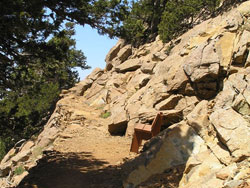|
Environment
Walking on Ancient Ground
The ground on the Troodos mountains is chiefly made up of three main rocks - diabase, gabbro and lava - which have the following common characteristics:
 They are mainly shallow, rocky and eroded with sharp, sudden inclines. They are mainly shallow, rocky and eroded with sharp, sudden inclines.- They do not contain calcium carbonate and the pH is usually neutral or slightly alkaline (7-7.8), which means that the ground colloids are saturated mainly with calcium and magnesium.
- They are mainly immature with no horizontal development on the ground profile. Where there is permanent natural vegetation (woods, bushes, etc.) a thin horizon is created on the surface, enriched with up to 5% organic material and a deep brown colour.
- Due to the steep inclines and shallowness of the particular ground, for it to be exploited for farming purposes, it would need to be flattened, for terraces to be built and to be cultivated deeply so as to create ground that is protected from erosion. With the addition of manure and fertiliser and speeded-up decomposition, gradually fertile land could be created with very good physical and chemical properties.
Walking on Diabase
Diabase comprises the major part of the mountain range and two thirds of it is found on the Troodos Ophiolite. The main types of clay are chlorite and vermiculite and the ground is usually brown in colour, medium composition, with very good ventilation and draining. Field capacity is around 25-28% and the wilting point about 16-18% of the dry weight of the ground. The mother rock is quite hard and for this reason it is hard to break down and turn into fertile land.
Limited gabbro
Ground on gabbro is limited to the central part of the range and it includes areas of the villages of Potamitissa, Dymes, Agros, Agridia, Kyperounda, Pano Platres, Trooditissa, Paliomylos, Prodromos, Pedoulas and Moutoullas. The prevalent type of clay here is kaolinite, halloysite and montmorillonite, while the ground is mainly grey in colour with a high sand content (up to 70%). The original material is very soft and easily broken up to create (in a short space of time after flattening) an excellent physical and chemical environment for the development of plant root systems. Field capacity is around 15-20% and the wilting point about 8-12% of the dry weight of the ground.
Unresearched lava
Ground covered by lava has not been studied adequately even though it forms a ring around almost all of the Troodos range, with its greatest and most compact presence in the north-eastern sections. Montmorillonite is the main mineral of the clay and the ground is usually shallow to deep, medium composition and olive coloured. It contains no calcium carbonate, except in areas adjacent to sedimentary rocks. Lava rocks generally break up easily and after flattening can quickly give an excellent ground environment for the growing of all plants. Field capacity is about 25-27% and the wilting point around 16-18% of the dry weight of the ground.
|